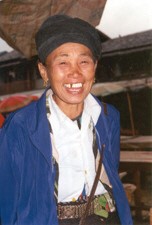Tai Daeng in Vietnam

Photo Source:
Copyrighted © 2026
Peoples of Laos, Asia Harvest All rights reserved. Used with permission |
Send Joshua Project a map of this people group.
|
| People Name: | Tai Daeng |
| Country: | Vietnam |
| 10/40 Window: | Yes |
| Population: | 175,000 |
| World Population: | 203,000 |
| Primary Language: | Tai Daeng |
| Primary Religion: | Ethnic Religions |
| Christian Adherents: | 1.50 % |
| Evangelicals: | 0.35 % |
| Scripture: | Translation Started |
| Ministry Resources: | No |
| Jesus Film: | No |
| Audio Recordings: | Yes |
| People Cluster: | Tai |
| Affinity Bloc: | Southeast Asian Peoples |
| Progress Level: |
|
Introduction / History
Making their way into Northern Vietnam from China by following the Red River, the Tai Daeng (AKA, Red Tai) finally settled in the region that is now known as Thanh Hoa Province, south of Sam Nuea. The Tai peoples emigrated south from China due to unending pressure by the Chinese. In 1884, the French colonized Vietnam, and in 1948, organized an independent Tai Federation. Communist rebels emerged, leading to the demise of the federation. North Vietnam became a communist nation in 1954. After a prolonged civil war, communism took the rest of Vietnam by 1975. The Tai Daeng (Red Tai) are closely related to the White and Black Tai, who were named for the color of their women's traditional clothing. Their tonal language, Tai Daeng, belongs to a larger ethno-linguistic grouping of people known as the Tai, which also include the Laotians, the Shan, and some other groups. They live in Laos as well as Vietnam.
What Are Their Lives Like?
The Tai Daeng are unusually polite, respectful and hospitable people. Beginning at a very young age, their children are taught proper social behavior. This code of conduct is based on having respect for those who rank higher. Additional emphasis is placed on becoming independent and self-reliant.
Tai Daeng society is very structured; it is organized on the basis of age, occupation and wealth. For example, farmers are ranked below craftsmen, merchants and city government officials. The priests form their own separate class. The basic unit of Tai Daeng society is the family, which is basically patriarchal or male-dominated. The immediate family usually live together, and there is mutual respect for one another at all levels. They live, eat, and farm together with the women working alongside their husbands. Newly married couples often live with the girl's family until they are able to establish their own separate home.
Wet rice farming dominates the Tai Daeng economy. Rice is grown both as a dietary staple and for cash sales. The Tai Daeng are noted for sharing the work equally. Both men and women plow, fish, cook, tend to the children, clean the house and wash the clothes.
When Vietnam made the transition to communism, all levels of Tai society were affected. Groups of independent farmers were organized into "community farms" that share equally in production. In addition, small-scale industrialization led to the entry of farmers into the Vietnamese working class. Communism also brought in more medical schools and better hospitals. This has helped to stop the spread of small pox, cholera, tuberculosis and malaria which were rampant in times past.
Prayer Points
Pray for a movement toward Jesus Christ that will result in church plants and discipleship.
Ask God to give Tai Daeng believers boldness to share Christ with their own people.
Ask the Holy Spirit to soften Tai Daeng hearts to Jesus Christ.